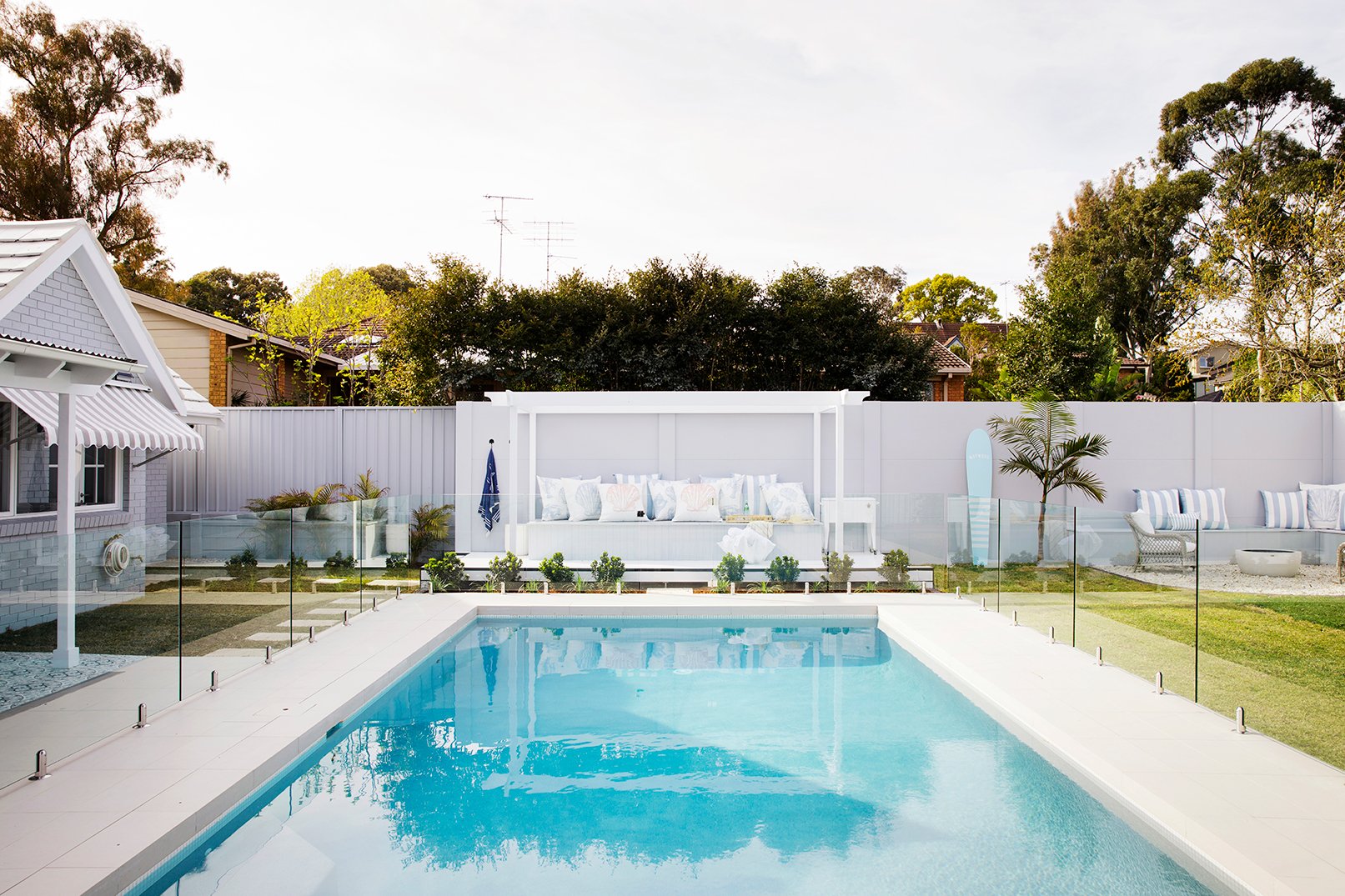STAY COOL, INSTALL A POOL! BUT CONSIDER THESE 6 THINGS BEFORE YOU DO
Three Birds House 8
Things are heating up for summer and although you may have missed the boat to get a pool in for this swimming season it’s never too soon to start planning your perfect pool. Here are 6 things you’ll want to consider to get you started…
1) WHAT DOES IT LOOK LIKE?
Three Birds House 13
Let’s start with the fun part! The best way to start designing your dream pool is by creating a vision board just for your pool area. You’ll be spoilt for choice of pool inspo pics because they’re such popular spaces to photograph! It seems that Europe was the place to be in 2023 and our Instagram feeds are flooded with amazing pool shots.
Pinterest is a great place to start collecting your inspo images. You can check out our Pinterest pool board here. When you’re creating your pool vision board, remember that it must embody the overall style of your home, so it helps to have your master vision board close by for reference too.
2) WHERE WILL YOU PUT IT?
The location of your pool is really important and can’t be determined in isolation of your landscaping and alfresco designs. If you’re working with limited space, you might not have many options but if your block is bigger you’ll need to work through the pros and cons of each possible position. For example:
At the back of your block
A great position to make use of the whole block but not so great for supervising little ones.
Three Birds House 6
Three Birds House 13
Close to the house
Your pool can provide a gorgeous water view from inside but might be noisy when filled with rowdy teenagers.
Side of the block
You get the best of both worlds in terms of proximity to the house but it might awkwardly cut your block in two.
Where you plan to put your pool will influence (or be influenced by) the size and shape of it. You might be interested to know that pool sizes have been getting smaller over the decades in response to urbanisation and smaller block sizes.
Today, the average family pool size in Australia is around 8 x 4 metres compared to 9 x 5 metres (or longer) in years gone by. And at the other end of the spectrum, we’ve also seen lots of people installing pools as small as 5 x 3.5 metres. The right size for you will likely be determined by the space you have available, taking into account factors such as avoiding large trees and sewer mains and deciding how much space you want around the pool too.
3) WHAT WILL IT BE MADE OF?
Once you know the look you want, you are ready to embark on the next big decision: fibreglass or concrete? Fibreglass pools have come a looooong way since the ones you may remember from the 80’s and Lana’s a huge advocate as they have some real advantages over their concrete equivalents.
Concrete
A custom concrete pool gives you complete control to create the pool of your dreams. It’s hard to beat the look of a concrete pool and there are so many options when it comes to surface finishes (glass bead, pebble or tile), shape and colour. With a custom concrete pool build you can add ledges, alcoves and swim-outs wherever you want them. If your heart is set on some stunning waterline tiles, you’ll need to opt for a concrete pool in order to achieve that premium finish. The downside of a traditional concrete pool is the lengthy timeline required to build the pool on-site. Most pool builders quote at least 3-months but with current conditions we’re hearing of 5-month + build times. In addition, the cost is typically more than a fibreglass pool.
More recently we’ve seen pre-fabricated concrete pools come onto the market which give the look of a concrete pool but have the benefit of faster installation. You can’t customise these pools a specific shape or size but can add a water line tile, exterior tile, render, paint or clad the shell to seamlessly suit your landscape and surrounds.
Fibreglass
Generally speaking, fibreglass pools cost around 20% less than a concrete pool to install and will have you swimming much faster because they can be installed in 3 weeks (instead of 3 months!). In addition, they’re warmer because the material acts as a natural insulator, gentler on little feet as the surface is non-abrasive and cleaner because the gel-coating is smooth and non-porous, preventing growth of mould and algae. Oh, and they’re also stronger! It’s hard to believe anything is stronger than concrete, but fibreglass is very durable and can withstand movements in the earth better than concrete.
The biggest drawback to fibreglass pools is that there are limited design and colour choices and it’s difficult to add a waterline tile.
4) WILL IT BE HEATED?
Has anyone noticed that newer generations can’t swim in anything less than 28 degrees (or without goggles!)? If this sounds like your kids, heating your pool might be a good option to ensure there are no excuses for this expensive investment not to be used and enjoyed. There are a few popular options when it comes to heating your pool…
GAS
This heats the pool quickly but can be costly to run, making it better suited to small pools and spas. Gas can be combined with solar heating and used as a ‘booster’ rather than the sole source of heat. You’ll need to ensure you have gas pipes near the pool area. Gas is the best option if having a warm pool at the flick of a switch is really important to you and you’re willing to pay for it. Unfortunately, gas is the least friendly option for the environment.
HEAT PUMP
The initial cost outlay is greater for this style of heating, but an electric heat pump is really cost-effective in the long term. It works like an air conditioner and isn’t reliant on the sun, although it’s not suited to climates below 10 degrees (who's swimming then anyway!?). It takes longer than gas to heat the pool, but if you give it a few days at the beginning of the season to reach the designated temperature (say, 28 degrees), from then on the thermostat should automatically switch on the pump when the temp drops below that. Heat pumps can cost almost nothing to run if you are collecting solar power to reduce your electrical bills.
SOLAR
If you get enough sun, solar energy can be the most cost-effective heating solution on an ongoing basis, despite there being a large initial outlay. Water is run through the pipes on your roof, warmed, and then returned to your pool. Sounds easy enough, but on rainy days and at night it won’t heat anything, so it can feel like one step forward, two steps back, and the water won’t feel that much warmer. And if your pool is located at the back of your garden, it’s a long way for the water to travel while maintaining its heat.
5) WHAT ABOUT THE WATER?
For a while there, it was all the rage to have a salt water pool rather than a chlorine one. And now, there’s also the option of mineral water. Modern mineral pools claim to deliver a range of health and wellbeing benefits because the tranquil water is filled with natural emollients that relax and rejuvenate you with every swim. A system like Theralux Advanced Mineral Pool System which we used in Bon’s pool harnesses the cleansing properties found in natural mineral baths and oceans around the world, eliminating the taste of salty water and the chemical smell of chlorine that lingers on your body long after you’ve left the pool. Any pool can be converted to a mineral pool system and Lana did this at her place a few years after it had been installed.
6) DON’T FORGET THE LANDSCAPING!
We hate to be the ones to break the bad news (but this will save you from breaking your budget down the track) - be aware that your landscaping might end up costing just as much as your pool, if not more! Ouch. By ‘landscaping’, we mean all of the poolside works that you’ll need to achieve your vision but your pool company might not include in the quote:
• Paving, tiling or decking around the pool
• Coping (that’s the first row of pavers or capping that surrounds the edge of your pool)
• Cabana or shade structure (check local regulations before you build as you can no longer build an ‘enclosed structure’ inside the pool fence.)
• Retaining walls
• Plants & greenery
• An outdoor shower
• Storage for pool toys
Most pool companies like to complete all the landscaping work around the pool themselves and can quote for that in addition to getting the pool in the ground. However, you can also choose to separate those activities out from their scope of work (in a bid to save money) and use a separate landscaping company instead. Just be aware that this will require a little more coordination and management on your end to ensure your landscaping team and the pool company work well together.
Want more details on planning your perfect pool? Module 6 of Three Birds Reno Schools is all about ‘Transforming the Exterior’ and there’s a dedicated lesson called ‘Pool Party’. We’ll teach you everything you need to know about your dream pool.
























